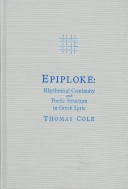Ancient metricians saw Greek verse in essentially paradigmatic terms, as a mosaic of discrete feet or phrases, each with its own name and each conforming, within a permitted range of variation, to some fixed model. The syntagmatic alternative to this view offered here represents the first attempt since the early nineteenth century to make a decisive break with inherited metrical categories and assumptions. It argues that feet and phrases, to the extent that they exist at all in Greek lyric verse, tend to be present at the level of parole rather than langue-constituting one of a number of possible ways of articulating some larger rhythmical continuum. These larger rhythmical structures, comparable to the movements of a piece of Classical Western music but allowing for a more fluid bar structure, a greater variety of basic time signatures, and more frequent modulation, are the minimal independent utterances in lyric discourse.
Recognition of their existence and character allows a reduction of the bewildering multiplicity of rhythmical nomenclature to something much more simple and manageable, as well as a clearer view both of the architectonics of the Greek stanza and of the main lines of its development during the three centuries (700-400 B.C.) when rhythmical innovation and experimentation were at their height. The organization of the book is partially by genres, partially historical; its use in the study of individual passages is facilitated by a full index locorum.
- ISBN10 0674258223
- ISBN13 9780674258228
- Publish Date 24 July 1988
- Publish Status Active
- Publish Country US
- Imprint Harvard Department of the Classics
- Format Hardcover
- Pages 288
- Language English
